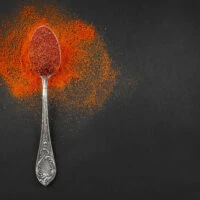Paprika is one of those spices that has left a mark on global cuisine, adding flavor and color to a wide variety of dishes. But what many don’t realize is that this beloved seasoning actually comes from something very familiar—peppers, specifically the Capsicum annuum variety. Unlike some rare or exotic spices, paprika doesn’t come from a special plant, but from peppers you might recognize from the grocery store.
Despite this common origin, paprika’s transformation from a simple pepper into a bold spice is fascinating. The process, though straightforward, varies based on the type of paprika being made. And whether it’s the smoky paprika found in Spanish dishes like paella or the mild sweet paprika used in Hungarian cooking, each type has its own unique journey.
How does this pepper become the versatile spice we all love? Let’s break it down.

Recent discussions on social media platforms suggest that many still believe that paprika comes from a unique plant, rather than the peppers we commonly see in the grocery store. To set the record straight and enhance your knowledge about this popular seasoning, this article delves into the process of making paprika, its variants, and the numerous health benefits it offers.
Learning that Paprika is just dried and crushed red bell peppers was really shocking. Like I dunno why I thought there was a Paprika tree somewhere
— Make Oxtail Cheap Again (@simsimmaaz) January 23, 2023
Yes you can make your own ❤️ pic.twitter.com/uEEfEaucr2
— Make Oxtail Cheap Again (@simsimmaaz) January 24, 2023
How Paprika is Made: From Peppers to Powder
Contrary to some misconceptions, paprika is not sourced from a specialized plant but is made from common peppers, specifically Capsicum annuum, which are dried and ground into a fine powder. This revelation might be a surprise for some, considering the distinct flavor profile and vibrant color that paprika brings to dishes. However, the journey of a pepper to paprika is a fascinating one that calls for further exploration.
- Pepper Selection: To start, specific types of peppers are used for making paprika. Although these peppers belong to the same family as bell peppers, they differ in shape and size, being longer and thinner. Interestingly, different varieties of peppers can lead to different types of paprika, thus adding to its versatility.
- Pepper Drying: Once the peppers are picked at the right time, they are subjected to a drying process. This step can involve sun-drying, smoke-drying, or oven-drying, each contributing its unique touch to the final taste of the paprika. For instance, the much-loved smoked paprika is made by smoke-drying the peppers, giving it a robust, smoky flavor that sets it apart.
- Pepper Grinding: After the drying process, the peppers are crushed into a powder, resulting in the final product we know as paprika.
In short, the process of making paprika may seem simple, but it’s the careful selection, drying, and grinding of peppers that gives this spice its unique flavor and versatility.
The Different Types of Paprika
Paprika isn’t just one flavor; there are actually a few different types that bring their own unique twist to your cooking. First up, we have sweet paprika. This one is mild, with no heat at all, but it adds a nice color and a touch of sweetness to dishes. You’ll often see it used in Hungarian food like goulash.
Then there’s hot paprika, which, as you can guess, has a bit of spice. It’s made from spicier peppers, so if you like your food with a little kick, this is the one to go for.
Finally, smoked paprika brings that deep, smoky flavor. The peppers are smoked before being ground, which gives the spice a bold taste that works really well in Spanish dishes like paella.
The Health Benefits of Paprika
Paprika isn’t just great for adding flavor to your food—it’s also packed with some surprising health benefits. For starters, it’s loaded with antioxidants like carotenoids, which help protect your cells from damage. That’s a big plus for overall health.
Another benefit is its anti-inflammatory properties. Thanks to the capsaicin found in some types of paprika, it can help reduce inflammation in the body. This might be especially helpful for people dealing with chronic inflammation or joint pain.
Paprika is also a good source of vitamin A, which is important for maintaining healthy vision. So next time you sprinkle it on your dish, remember it’s doing more than just making your food look good—it’s giving your eyes some extra support too.
Lastly, paprika may even aid in digestion. Some research suggests that the capsaicin in paprika can boost stomach acid production, which helps with breaking down food and keeping your gut healthy.
Natural Food Preservation
While we often think of paprika as just a spice to enhance flavor, it has historically served another important purpose—preserving food. In traditional methods of food preservation, especially in cured meats like Spanish chorizo and Hungarian sausages, paprika plays a key role. Thanks to its natural compounds, particularly capsaicin, paprika helps inhibit the growth of bacteria, acting as a natural preservative.
This preservation quality was essential before modern refrigeration, allowing meats to be stored for longer periods without spoiling. The addition of paprika not only added flavor but also extended the shelf life of foods in warm climates, where spoilage was a greater risk. Even today, this tradition continues in various regions, proving that paprika’s value goes beyond taste.
Paprika’s Flavorful Journey

Paprika is more than just a vibrant spice that adds color to your dishes. From its humble beginnings as a dried pepper to its variety of flavors—sweet, spicy, or smoky—it has earned its place in kitchens around the world. Plus, with its impressive health benefits, like boosting antioxidant levels and supporting eye health, paprika proves that it’s not only tasty but also good for you.
Next time you sprinkle some paprika on your favorite dish, take a moment to appreciate the journey it’s been through and the goodness it brings to the table.



